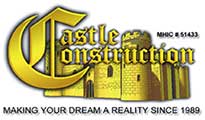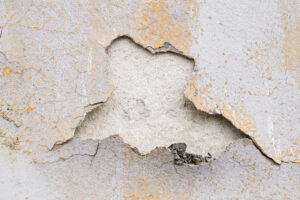Termites are a common household pest that can cause significant damage to a home’s structure. One of the most common areas for termite damage is drywall. Early-stage termite damage to drywall can be difficult to detect, but it is important to catch it early to prevent further damage and costly repairs. Termite damage to drywall can be caused by both subterranean and drywood termites. Subterranean termites typically enter a home through the foundation, while drywood termites enter through exposed wood. Once inside, they can quickly begin to eat away at the drywall, causing structural damage and weakening the integrity of the wall. Early signs of termite damage to drywall include small holes or cracks, buckling or warping, and the presence of termite droppings or mud tubes. It is important to address these signs as soon as possible to prevent further damage.
Identifying Early-Stage Termite Damage
Early stage termite damage can be difficult to detect, as the damage may not be visible on the surface of the drywall. However, there are a few signs that homeowners can look out for to identify early stage termite damage.
One of the most common signs of termite damage is the presence of small holes or tunnels in the drywall. These holes may be difficult to see, but they can be detected by tapping on the drywall with a screwdriver or other hard object. If the drywall sounds hollow or if the screwdriver easily punctures the surface, this may indicate the presence of termite damage.
The Risks of Ignoring Early Signs
Early detection and intervention are crucial when it comes to termite damage in drywall. Ignoring these early signs can lead to severe structural issues, compromising the integrity of your home. Termites don’t stop at drywall; they can wreak havoc on wooden structures and even furniture.
Another sign of early stage termite damage is the presence of tiny piles of sawdust or wood shavings near the baseboards or other wooden structures in the home. This sawdust is created by the termites as they tunnel through the wood and can indicate the presence of an active termite infestation.
Homeowners may also notice that their walls or ceilings appear to be sagging or bulging in certain areas. This can be a sign of termite damage, as the termites may be eating away at the wood inside the walls or ceilings.
Understanding Termite Behavio
Termites are social insects that live in colonies and feed on cellulose-containing materials, such as wood, paper, and drywall. They play an important role in the ecosystem by breaking down dead plant material, but they can also cause significant damage to homes and other structures.
Termites are attracted to moisture and warmth, which is why they often infest areas that are damp or humid. They are also attracted to wood that is in contact with soil, as it provides them with easy access to food and water. Termites are very small and difficult to detect, as they often tunnel through wood and other materials without leaving any visible signs of damage. However, there are some signs that homeowners can look for to identify a termite infestation, such as:
Mud tubes: Termites build mud tubes to travel between their nest and their food source. These tubes are usually about the width of a pencil and can be found on walls, foundations, and other surfaces.
Swarming: When termites are ready to form a new colony, they will swarm in large numbers. Swarms usually occur in the spring and fall and are often mistaken for flying ants.
Wood damage: Termites can cause significant damage to wood, leaving behind long grooves and tunnels. They can also cause drywall to sag or buckle.
It’s important to address a termite infestation as soon as possible, as they can cause significant damage to a home or structure if left untreated. Homeowners can take steps to prevent termite infestations by keeping their home dry and well-ventilated, sealing cracks and openings in the foundation, and removing any wood debris or other cellulose-containing materials from around the home.
Impact of Termite Damage on Drywall
Termites are known to cause severe damage to wooden structures, but they can also cause damage to drywall. Early-stage termite damage to drywall can be difficult to detect, but it can lead to significant problems if left untreated. When termites infest a home, they can chew through drywall, leaving behind small holes and tunnels. Over time, these holes can weaken the structural integrity of the drywall, causing it to sag or even collapse. In addition to compromising the strength of the drywall, termite damage can also create unsightly blemishes on walls and ceilings.
One of the most significant impacts of termite damage on drywall is the potential for mold growth. When termites chew through drywall, they create openings that allow moisture to seep in. This moisture can create the perfect environment for mold to grow, which can lead to health problems for those living in the home.
Repairing termite damage to drywall can be a complicated process
The first step is to eliminate the termite infestation and repair any structural damage caused by the pests. Once the termite problem has been resolved, the damaged drywall must be removed and replaced. In some cases, it may be necessary to replace entire sections of drywall to ensure that the new drywall is properly secured and structurally sound.
In conclusion, termite damage to drywall can have a significant impact on the structural integrity and appearance of a home. It is important to address any signs of termite damage as soon as possible to prevent further damage and potential health hazards.
Preventive Measures Against Termite Damage
There are various preventive measures that homeowners can take to protect their homes against termite damage. These measures include:
Regular inspections: Homeowners should have their homes inspected by a professional pest control company at least once a year. This will help detect any signs of termite activity early on and prevent extensive damage.
Moisture control: Termites thrive in moist environments, so homeowners should ensure that their homes are properly ventilated and free of excess moisture. This can be achieved by fixing leaky pipes, ensuring proper drainage, and using dehumidifiers.
Wood treatment: Applying a termite-resistant treatment to wooden structures can help prevent termite damage. Homeowners can use products such as borate solutions, which are applied to the wood and act as a barrier against termites.
Termite barriers: Physical termite barriers can be installed around the perimeter of the home to prevent termites from entering. These barriers can be made from materials such as stainless steel mesh, crushed rock or concrete.
Regular maintenance: Homeowners should ensure that their homes are well-maintained and any damage is repaired promptly. This includes fixing leaks, sealing cracks and crevices, and replacing damaged wood.
By taking these preventive measures, homeowners can significantly reduce the risk of termite damage to their homes.
Repairing Early Stage Termite Damage
When it comes to repairing early stage termite damage, there are a few things to keep in mind. First and foremost, it’s important to identify the extent of the damage. If the damage is minimal, it can be repaired with a simple patch. However, if the damage is more severe, it may require the replacement of the entire drywall panel.
To repair minor termite damage, follow these steps:
Clean the damaged area: Use a soft brush or cloth to remove any dirt or debris from the damaged area. This will ensure that the patch adheres properly.
Apply joint compound: Apply a thin layer of joint compound to the damaged area using a putty knife. Be sure to spread the compound evenly.
Apply the patch: Cut a piece of drywall slightly larger than the damaged area. Place the patch over the damaged area and press it firmly into the joint compound. Smooth out any air bubbles or wrinkles.
Apply a second layer of joint compound: Once the patch is in place, apply a second layer of joint compound over the top of the patch. Be sure to feather the edges of the compound to blend it in with the surrounding area.
Sand and paint: Once the joint compound has dried, sand it smooth and paint over the repaired area to match the surrounding wall. If the damage is more severe, it may be necessary to replace the entire drywall panel. This is a more complex repair and may require the help of a professional.
In summary, repairing early stage termite damage can be a straightforward process if the damage is minimal. However, if the damage is more severe, it may require the replacement of the entire drywall panel.
FAQs for Early Stage Termite Damage in Drywall
How do termites enter my home?
Termites can enter through cracks in the foundation, gaps in utility lines, or even via mud tunnels they construct.
Can I treat termite damage myself?
While some DIY treatments are available, it’s often best to consult a professional to ensure thorough eradication and prevention.
Do all termites eat drywall?
No, while some species are more likely to target drywall, others prefer wood or cellulose-based materials.
Are there natural ways to repel termites?
Certain essential oils, like cedarwood and neem oil, can act as natural termite repellents.
How much does termite damage repair cost?
Costs vary depending on the extent of damage, but repairs can range from hundreds to thousands of dollars.
Can I use termite-resistant paint?
Termite-resistant paint can add an extra layer of protection, but it should not be relied upon as the sole defense against termites.
Conclusion
Early stage termite damage in drywall is a serious concern for homeowners, but with vigilance and preventative measures, you can protect your investment. Don’t wait until the damage becomes extensive and costly to repair. By staying informed and taking action, you can keep your home termite-free and your drywall intact.


